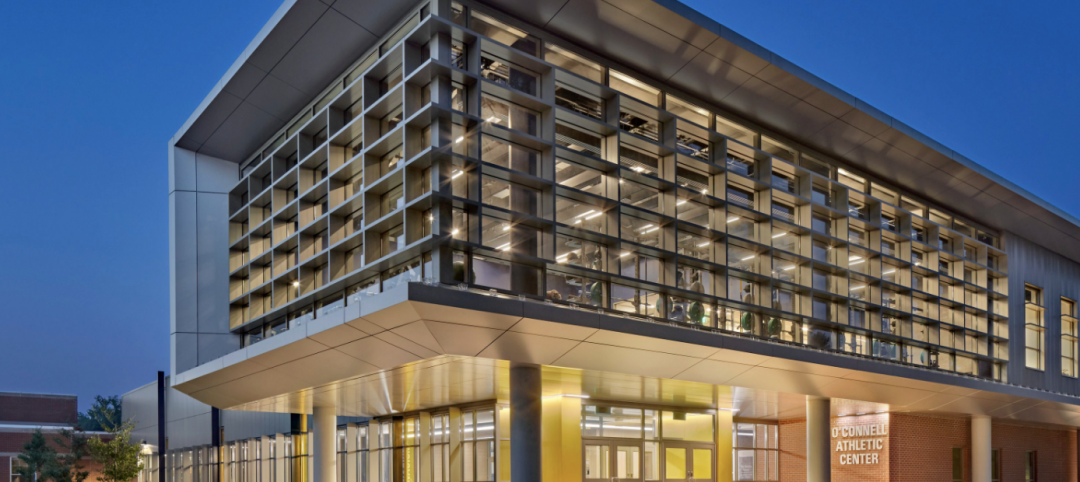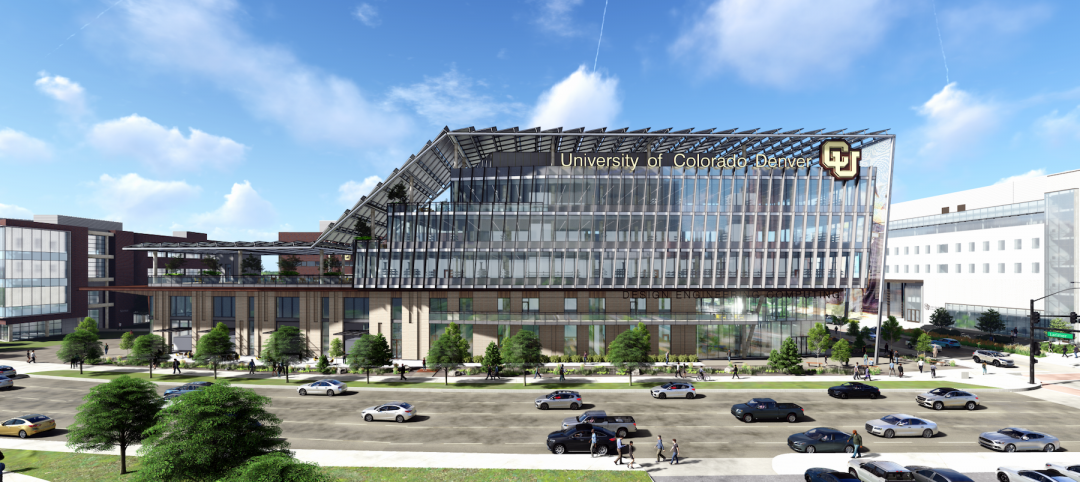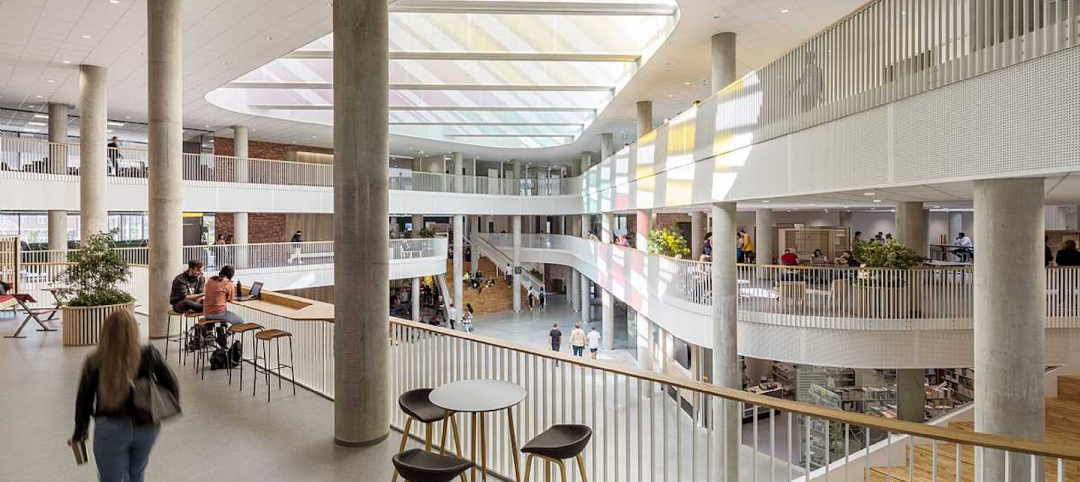On Monday, Columbia University held a dedication ceremony for its 17-acre Manhattanville campus in the West Harlem section of New York City. This $6.3 billion campus, which when completed will comprise 6.8 million sf of new academic space, is the university’s most ambitious expansion since it relocated to its current campus at Morningside Heights in Harlem 119 years ago.
The new campus, which was master planned by Skidmore Owings & Merrill and Renzo Piano Building Workshop, has been in the works since 2003, roughly around the time Lee C. Bollinger became the university’s president. “We knew that Columbia had to have new space to fulfill its mission as a great university,” said Bollinger during the dedication’s luncheon, held inside the 450,000-sf Jerome L. Greene Science Center, Manhattanville’s first building to open.
The Center, which should be fully occupied by next spring, is home to the Mortimer B. Zuckerman Mind Brain Behavior Institute. (The publisher and philanthropist Mort Zuckerman; Christina McInerney, president and CEO of the Jerome L. Greene Foundation; three Nobel Prize laureates and two Pulitzer Prize winners were among the dignitaries in attendance.)
Over the next two years, the Manhattanville campus will open the 60,000-sf Lenfest Center for the Arts, which will feature the Miriam and Ira D. Wallach Art Gallery, a 150-seat screening room, and a 4,300-sf presentation space; and the 56,000-sf University Forum, with a 430-seat auditorium.
Eric Kandel, MD, co-director of the Zuckerman Mind Brain Institute (and a Nobel Laureate in 2002 for the category physiology or medicine), proclaimed this project “historically important” to the university’s stature as well as for accentuating the symbiosis on campus between “bioscience and the arts.”
By 2021, the Ronald O. Perlman Center for Business Innovation and the Henry Kravis Building—492,000 sf across two buildings designed by Diller Scofidio + Renfro in collaboration with FXFowle Architects—will be the new home for the Columbia Business School.
Architect Renzo Piano describes the Jerome L. Greene Science Center in relation to its surrounding environment, which includes New York City's West Side Highway and the Hudson River. Image: BD+C
Architect Renzo Piano spoke at the dedication, at which he referred to the Jerome L. Greene Science Center as both a “palace” and a “factory that explores the secrets of the mind.” Piano also talked about the “urban layer” that will connect the campus to the community via reversed ground-floor setbacks, widened sidewalks, the absence of walls or gates (which is in marked contrast to the fortress-like Morningside Heights campus), height limitations (the Center is nine stories above ground), and a custom-glazed curtainwall.
His firm designed the Center to be as transparent as possible. The facility’s first floor, in fact, is open to the public. And its offices, labs, and other workspaces are organized on an open floor plan, divided into quadrants along North-South/East-West axes that expose workers and visitors to ample daylight.
Jerome L. Greene Science Center is across the street from an elevated subway line whose noise level measures 88 decibels. To mitigate that noise, the building was designed with a double-pane glass wall system whose 16-inch-wide air cavity in between exhausts air from the HVAC system and lets occupants open windows and glass doors from the inside. Open-air staircases connect the floors and encourage interaction between departments.
A 75,000-sf central energy plant, beneath the Greene and Lenfest buildings, will deliver electricity, chilled water, and high-pressure steam to nearly all of the buildings on campus.
The exterior bracing is visible to call attention to Greene’s “industrial” affinity with surrounding buildings in the neighborhood. That connection is reinforced by Columbia’s adaptive reuse of existing buildings on Manhattanville’s campus—specifically a one-time Studebaker auto-manufacturing plant and milk processing plant—that now serve, respectively, as university administration offices and Columbia’s center for the study of jazz and computer-generated music.
Manhattanville was the original name of this neighborhood, and Columbia and its AEC partners are at great pains to position this campus expansion as integral to a community that in the past has been wary about the university’s growth intentions. Bollinger, in his comments, went so far as to state that the new campus “is the best thing that could happen to upper Manhattan.”
Outdoor plazas within the campus will be accessible to the general public. The Jerome L. Greene Science Center will include a 1,920-sf Wellness Center that conducts free programs to raise awareness about stroke and related risk factors, and trains local residents to become community health workers. The Wellness Center will also be home to Mental Health First Aid, a program dedicated to improving the quality of mental health services in Upper Manhattan.
A 1,500-sf Education Lab within the Center will provide programs about brain science for the community and K-12 schools. Columbia has contracted with BioBus, an independent nonprofit, to run this program, and to bring learning into the community.
“This campus puts Columbia into the world,” observed Marilyn Jordan Taylor, a consulting partner with SOM (where she spent 33 years) and the former dean of the University of Pennsylvania’s School of Design.
Columbia|Manhattanville’s buildings are targeting LEED Platinum ND certification. Lendlease and McKissack Construction are the construction managers on the Greene and Lenfest buildings, Skanska and Velez Organization are the CMs on the University Forum building. And Turner will be the CM on the business school.
Related Stories
University Buildings | May 9, 2022
An athletic center accentuates a college’s transformation
Modern design and a student health center distinguish the new addition at The University of Saint Joseph in Connecticut.
Sponsored | BD+C University Course | May 3, 2022
For glass openings, how big is too big?
Advances in glazing materials and glass building systems offer a seemingly unlimited horizon for not only glass performance, but also for the size and extent of these light, transparent forms. Both for enclosures and for indoor environments, novel products and assemblies allow for more glass and less opaque structure—often in places that previously limited their use.
Education Facilities | Apr 28, 2022
ProConnect Education (K-12 to University) comes to Scottsdale, AZ, Dec 4-6
ProConnect Education 2022 will attract building product specifiers and manufacturers to the Andaz Resort in Scottsdale, Ariz., in December.
Sports and Recreational Facilities | Apr 27, 2022
New Univ. of Texas Moody Center houses men’s and women’s basketball, other events
The recently completed 530,000 sf University of Texas Moody Center is the new home for men’s and women’s basketball at the Austin campus.
Architects | Apr 22, 2022
Top 10 green building projects for 2022
The American Institute of Architects' Committee on the Environment (COTE) has announced its COTE Top Ten Awards for significant achievements in advancing climate action.
University Buildings | Apr 18, 2022
SmithGroup to design new Univ. of Colorado Denver engineering, design, computing building
The University of Colorado Denver selected SmithGroup to design a new engineering, design, and computing building that will serve as anchor of new downtown innovation district.
Projects | Apr 1, 2022
University complex encourages exchange between academics and residents
In the small Danish city of Horsens, C.F. Møller Architects has created a university complex that unites higher education with urban life—creating synergies among students, staff, businesses, and residents
Energy-Efficient Design | Mar 25, 2022
University of Pittsburgh Releases ‘Pitt Climate Action Plan’
The University of Pittsburgh has released the Pitt Climate Action Plan, detailing how the University will achieve its goal to go carbon neutral by 2037 through investments in clean energy, transportation, efficiency and other areas.
Higher Education | Mar 24, 2022
Higher education sector sees 19 percent reduction in facilities investments
Colleges and universities face a growing backlog of capital needs and funding shortfalls, according to Gordian’s 2022 State of Facilities in Higher Education report.
Projects | Mar 16, 2022
Tomorrow’s STEM leaders get a state-of-the-art research complex
In February, North Carolina Agriculture and Technical State University (NC A&T) opened its new Engineering Research & Innovation Complex (ERIC).
















